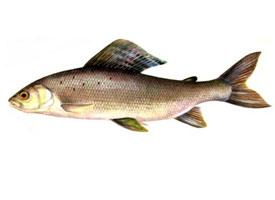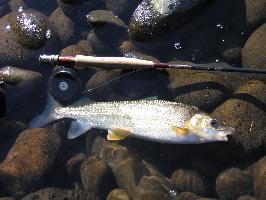
Données biologiques
| Durée de vie | de 3 à 5 ans |
|---|
Statut de conservation
| Menacé |
Description de l'animal
The River Trout, scientifically known as Salmo trutta, is a captivating species of freshwater and saltwater fish that belongs to the Salmonidae family. This species is highly adaptable and has a widespread distribution, making it a common sight in the rivers and coastal waters of Europe, but it can also be found in parts of Asia and North Africa. The river trout is celebrated not only for its ecological significance but also for its popularity among anglers and culinary enthusiasts.Physical Characteristics:
The river trout exhibits a remarkable degree of variability in size, color, and markings, which can significantly differ depending on its habitat, age, and the specific subspecies. Typically, these fish display a streamlined body that is perfect for navigating the fast-flowing rivers where they often reside. Their body coloration is equally fascinating, usually featuring a silvery, brownish, or olive green background, adorned with dark spots that can be surrounded by lighter halos. This camouflaging technique is a natural adaptation that helps protect them from predators. The average size of a river trout can range from 20 to 40 centimeters (8 to 16 inches) in length, though some specimens in ideal conditions can grow significantly larger.
Life Cycle and Reproduction:
River trout have a complex life cycle that can include both freshwater and marine phases, depending on the subspecies. The anadromous form, known as the sea trout, migrates to the ocean to mature, returning to freshwater only to spawn. In contrast, the freshwater forms, often referred to as brown trout, spend their entire lives in rivers or lakes. Spawning typically occurs in late autumn or early winter when females select gravel beds in clean, well-oxygenated water to lay their eggs. Males then fertilize these eggs, which remain in the gravel throughout the winter until they hatch in early spring. The juvenile trout, known as fry, then begin their journey, facing numerous predators and environmental challenges.
Diet and Predation:
River trout are opportunistic feeders with a diet that can include insects, crustaceans, mollusks, and smaller fish. Their predatory nature is evident in their feeding habits, as they are known to lie in wait for their prey, using their excellent camouflage to ambush unsuspecting victims. This predatory behavior starts young, with fry quickly learning to fend for themselves in the competitive river environment.
Ecological Role and Conservation:
As a key species in their ecosystems, river trout play a critical role in maintaining the health and balance of freshwater habitats. They are both predators and prey, contributing to the control of insect populations and serving as a vital food source for larger predators, including birds and mammals. However, river trout populations face threats from habitat loss, pollution, overfishing, and climate change. Conservation efforts are essential to ensure the sustainability of these populations, involving habitat restoration, pollution control measures, and regulated fishing practices.
In conclusion, the river trout (Salmo trutta) is a species of great versatility and beauty, embodying the complexity of aquatic ecosystems. Its presence in a body of water indicates environmental health and biodiversity. Through concerted conservation efforts, we can ensure that future generations will continue to enjoy and benefit from the presence of this remarkable fish in our rivers and streams.
Animaux similaires
Nouvelles photos d'animaux
Top 10 des animaux
- Dolphin gull (Leucophaeus scoresbii)
- Japanese macaque (Macaca fuscata)
- Stone loach (Barbatula barbatula)
- Greek tortoise (Testudo graeca)
- Russian tortoise (Testudo horsfieldii)
- Galápagos tortoise (Geochelone nigra complex)
- Diana monkey (Cercopithecus diana)
- Moustached guenon (Cercopithecus cephus)
- Common flying dragon (Draco volans)
- Galápagos penguin (Spheniscus mendiculus)


